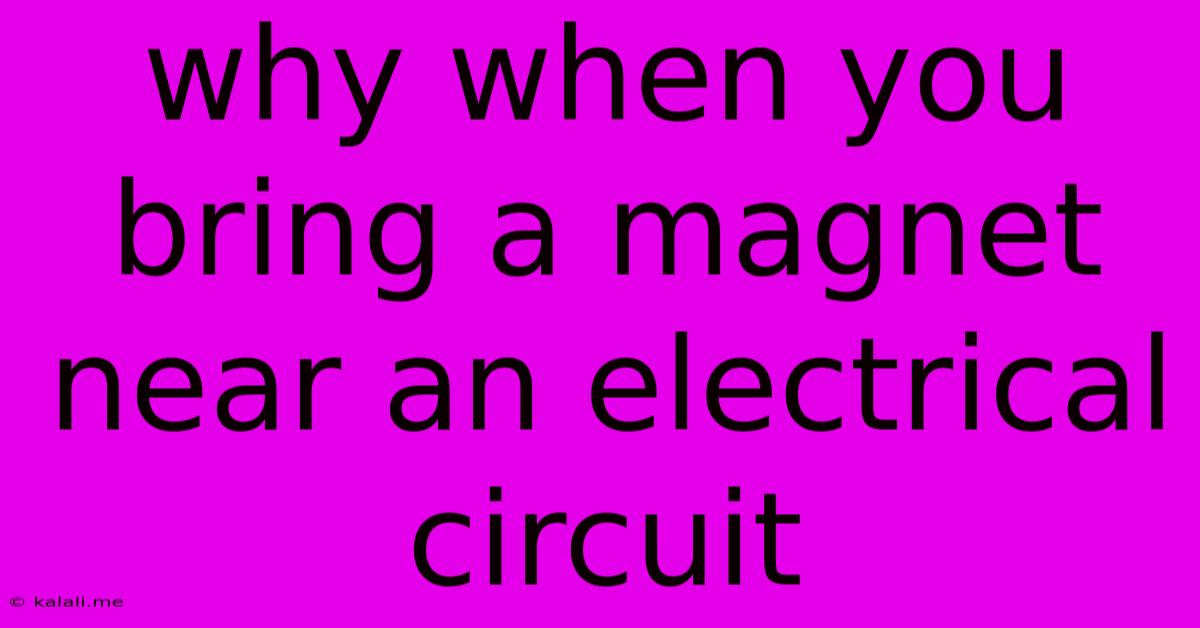Why When You Bring A Magnet Near An Electrical Circuit
Kalali
Jun 03, 2025 · 3 min read

Table of Contents
Why Bringing a Magnet Near an Electrical Circuit Can Be Interesting (and Sometimes Problematic)
Electromagnetism is a fascinating field, and one of the most intriguing demonstrations involves bringing a magnet near an electrical circuit. This seemingly simple action can have surprising and significant consequences, depending on the type of circuit and the strength of the magnet. This article will delve into the fundamental principles behind this interaction and explore the various effects it can produce.
What happens when you bring a magnet near a circuit? The short answer is: you induce a current. This is due to the principle of electromagnetic induction, discovered by Michael Faraday. A changing magnetic field can induce an electromotive force (EMF), or voltage, in a nearby conductor. This induced voltage, in turn, can drive a current through the circuit if a closed path exists.
Understanding Electromagnetic Induction: The Core Principle
The key is the change in the magnetic field. A stationary magnet near a stationary circuit won't induce a current. However, if you move the magnet closer or farther away, rotate it, or even just change the orientation of the circuit relative to the magnet, you alter the magnetic flux through the circuit. This changing flux is what generates the EMF. The strength of the induced current depends on several factors:
- Strength of the magnet: Stronger magnets produce stronger magnetic fields, leading to a larger induced EMF and current.
- Speed of movement: Faster movement of the magnet or the circuit results in a more rapid change in magnetic flux, hence a higher induced EMF and current.
- Number of turns in the coil: If the circuit involves a coil of wire (like in a solenoid or transformer), more turns mean a larger induced EMF.
- Angle between the magnetic field and the coil: The maximum EMF is induced when the magnetic field lines are perpendicular to the plane of the coil.
Practical Demonstrations and Applications
This principle isn't just theoretical; it has numerous practical applications:
- Generators: Electric generators rely heavily on this principle. Rotating magnets induce a current in coils of wire, generating electricity. This is how power plants produce much of the world's electricity.
- Transformers: Transformers use changing magnetic fields to transfer electrical energy between circuits with different voltages. This is crucial in power transmission and distribution systems.
- Wireless charging: Some wireless charging systems use inductive coupling to transfer energy between a charging pad and a device. The charging pad contains a coil that generates a changing magnetic field, which induces a current in a receiving coil in the device.
- Metal detectors: Metal detectors work by generating a changing magnetic field and detecting the small currents induced in metallic objects.
Potential Problems and Considerations
While electromagnetic induction has many beneficial applications, there are also potential problems:
- Induced currents can damage sensitive electronics: Strong magnets near circuits could induce large enough currents to damage components or disrupt their operation. This is especially true for delicate electronic devices or integrated circuits.
- Interference with other devices: Induced currents can create electromagnetic interference (EMI) that affects nearby devices, leading to malfunctions or data corruption.
In conclusion, bringing a magnet near an electrical circuit is far from a simple interaction. It showcases the fascinating relationship between electricity and magnetism, underpinning many crucial technologies. Understanding the principles of electromagnetic induction is essential for engineers, physicists, and anyone interested in the workings of modern electronics. However, it's crucial to exercise caution when working with strong magnets and sensitive electronic equipment to avoid potential damage or interference.
Latest Posts
Latest Posts
-
Why Should You Have Shielded Rj45 Connectors
Jun 04, 2025
-
How To Tell If Your Rabbit Is Male Or Female
Jun 04, 2025
-
Wire Size For 30 Amp Breaker
Jun 04, 2025
-
How To Take Paint Off Tile
Jun 04, 2025
-
Sql To Search Stored Procedures For Text
Jun 04, 2025
Related Post
Thank you for visiting our website which covers about Why When You Bring A Magnet Near An Electrical Circuit . We hope the information provided has been useful to you. Feel free to contact us if you have any questions or need further assistance. See you next time and don't miss to bookmark.